Airlines, common outposts of casual banter, are no stranger to the ire of travelers. In a world post-2008, when airlines introduced a slew of ancillary fees, such as baggage and change fees to augment their quickly sinking revenues, scrutinizing the performance of airlines seems almost ingrained in our beings. The Airline Quality Index, calculated by researchers at Embry-Riddle Aeronautical University and Wichita State University, attempts to quantify airline performance, weighing factors such as on-time performance, rate of lost baggage, rate of passengers denied boarding on overbooked flights, and rate of complaints.
The two Dallas-based airlines, American Airlines and Southwest Airlines, finished near the middle of the pack. The study, released on April 7, ranked Southwest eighth and American ninth among qualified carriers (see the full table here, and the full report here). While not necessarily impressive, these results reflect stability in Dallas air travel, as both American and Southwest appear financially secure following recent mergers with US Airways and AirTran, respectively. That said, American and Southwest appear angled in different directions, with the dawn of American’s merger threatening its short-term future and with the sunset of Southwest’s merger signaling a promising future for the airline.
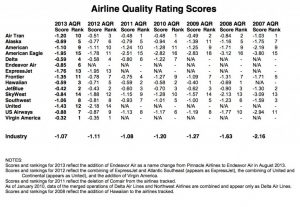
Because this survey analyzes only the calendar year of 2013, only a small fragment of the survey reflects the period following the American-US Airways merger, approved in December. Therefore, 2014 will prove far more telling for the newly-blended airline. Labor relations with American Eagle, its regional partner named the nation’s worst airline by the study, represents the greatest challenge for American, as stalled contract talks threaten the long-term future of its regional service.
A pilot shortage currently engulfs the nation, leaving a void of pilots to command these regional aircraft. Furthermore, meager pay, often starting at a mere $20,000, complicates the problem and may dissuade individuals from pursuing a future career in aviation. Unfortunately, while demand clearly outweighs supply, the airlines hold all of the power, subjecting their regional carriers to unfair contracts, capping the amount of revenue they can earn.
Airlines generally prefer to focus on higher yield passengers and higher capacity planes, as the fifty-seat aircraft American Eagle flies offer too few seats per flight to generate a sizeable profit. Other airlines, such as Delta and United, have drastically scaled back regional service, leaving cities like Cincinnati and Cleveland, former regional hubs, in the dust. DFW, a primary hub for American, appears safe, but Dallas consumers may nonetheless see a loss of flights to small or medium sized cities in the near future.
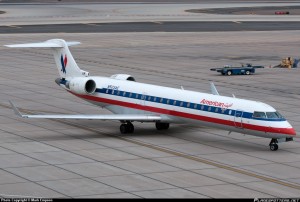
On March 28, American Eagle pilots rejected a new contract, leading to speculation that regional service may endure cuts. Regional airlines are a dying breed in general, and American Eagle is no exception. Even CEO Pedro Fabregas appears skeptical about its flying future, instead hinting, in a letter to employees, that the company may reorient itself toward ground handling: “Our ground handling operation continues to thrive and we have added new business and employees there at a rapid pace,” he said in February. American Eagle “will continue to work toward making our flying operation as competitive as possible while addressing the downsizing of our fleet and related staffing in the coming years.”
American’s ability to manage labor tension, as well as the smooth integration of US Airways, its employees and its fleet under the American brand, challenges its ability to maintain its number nine position in the short term. Much of the merger’s legwork remains yet to be completed. US Airways’ “checkered” merger history, according to Dean Headley, one of the report’s authors, forecasts a relatively turbulent integration process, much more cumbersome than, say, the Southwest-AirTran deal.
Southwest, headquartered at Love Field, maintained its 2012 position, ranked number eight on the list. This halted Southwest’s gradual slide down the list. Like American, Southwest faces labor tension and integration challenges in 2014. However, the relatively advanced stage of the merger looks promising for the airline’s future performance.
Completed in 2011, the Southwest-AirTran merger only recently gained some steam, explaining its mediocre position on the list. Southwest and AirTran, while operating under similar business models, are not totally compatible; several key differences between the two airlines – namely, whether AirTran would charge for baggage, a fundamental marketing point for Southwest – posed distinct challenges. Southwest – famous for its “Bags Fly Free” slogan – draws attention for its blatant refusal to charge for baggage, a policy adopted by essentially all of its competitors. AirTran fell steeply, dropping from third to tenth this year, likely stemming from consumer frustration with its lack of parity with Southwest, especially in such visible areas like baggage fees.
The acceleration of the merger may also feel threatening to AirTran’s employees, who face far more insecurity than those under the Southwest brand, the incumbents in this merger. The perception of insecurity, whether tangible or not, almost always compromises customer service. Some finality regarding the integration process will likely assuage some of these fears. Over its forty year history, Southwest has avoided – even during the 2008 recession – ever laying off employees, an otherwise common component of mergers, and should not be expected to issue pink slips now.
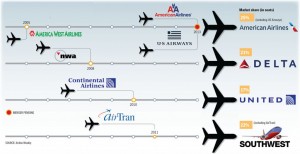
Southwest registered one of the lowest on-time percentages (76.7%) in the industry last year. However, much of this can be attributed to its strong position in Chicago (MDW) and Atlanta (ATL), both of which suffered especially treacherous weather unlikely to be repeated. Only the year before, Southwest’s on-time percentage surpassed 83%, pointing to volatile weather as a primary cause for why airline predicated on efficiency would endure such a sudden precipitous drop.
However, while delaying more flights than usual in 2013, Southwest placed among the leaders (second, according to FlightStats.com) in rate of cancellation. On-time percentage considers any flight arriving later than fifteen minutes past its scheduled time “late” from those squeaking in sixteen minutes past their schedule time to those entirely cancelled. But not all delays are created equal, and placing all delayed flights in parity obfuscates the portrait of airline performance.
Cancellations impose a far greater burden on travelers than delays, often stranding them in messy hub airports for at least a day, if not longer. Honing in on rate of delay over-dramatizes Southwest’s 2013 turnout negatively, and ignores its exemplary performance in an area that commonly hurts customers the most.
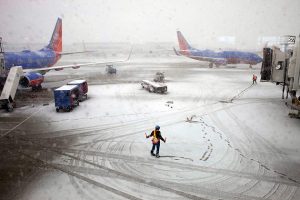
On-time percentage warrants further questioning, as it allows larger airlines, such as American, United, and Delta, to shield its flights operated by regional carriers from the calculation. These are generally the first routes delayed or cancelled during inclement weather. Therefore, this statistic may exaggerate Southwest’s on-time struggles. “The numbers are bogus,” claims Michael Boyd, an aviation expert with Boyd Group International. “We don’t know whether Southwest has a better or worse on-time performance. All we know is that they report all of their flights. There are whole chunks of what’s flown by other airlines that we don’t know about.”
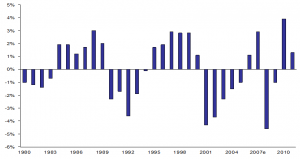
Ultimately, consumers should regard the Airline Quality Index for what it is: a single perspective, a single tool in a toolkit filled to the brim with metrics and observations. Looking to the immediate future, Southwest appears poised for takeoff, while merger clouds may overhang American in 2014.






